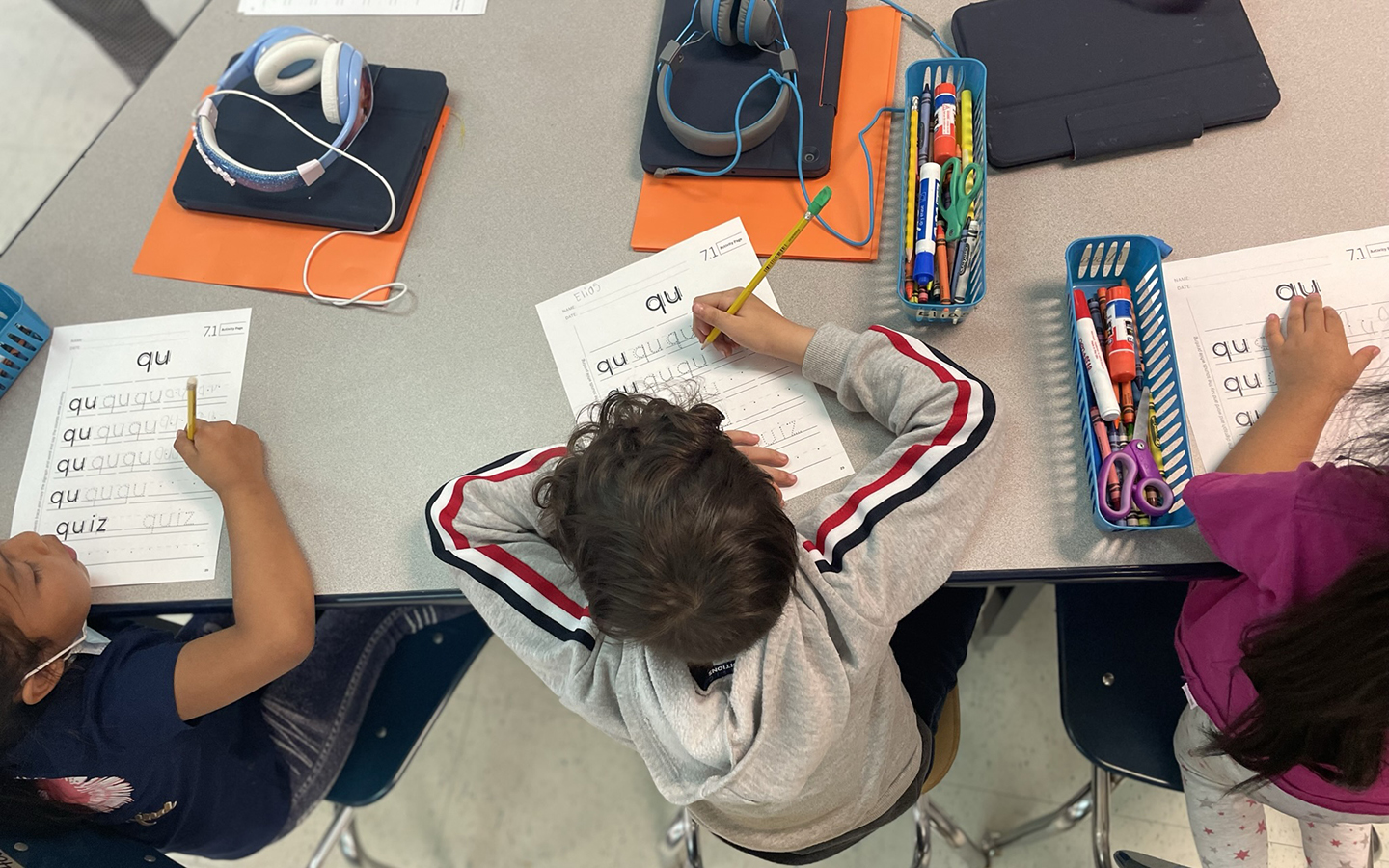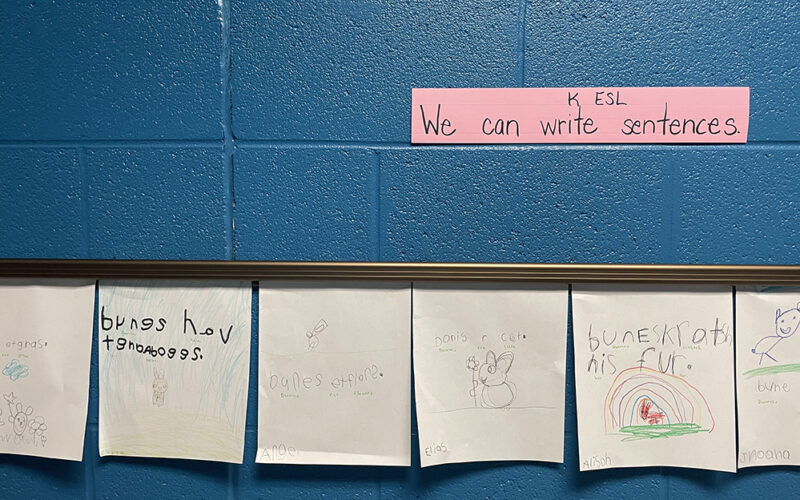How Literacy Skills Developed for English Language Learners in Weeks, Not Months
At this Tennessee district, a new curriculum helped English Language Learners blend consonant-vowel-consonant words in just six weeks

Get stories like this delivered straight to your inbox. Sign up for The 74 Newsletter
This is the third in a series of three articles from a Knowledge Matters Campaign tour of school districts in Tennessee spotlighting the impact of the state’s investment in training all teachers in the science of reading. Lebanon Special School District adopted a “sounds first” literacy curriculum alongside the Tennessee Foundational Skills Curriculum Supplement at the beginning of the 2020-21 school year across grades K-2 and was designated a “Reading 360 Model District” in September 2021. In this piece, K-5 English as a Second Language teacher Candace Reed shares what just one year of high-quality foundational skills instruction has meant for her English language learners and her school. Follow the rest of our series and previous curriculum case studies here.
“I can read it!” “Me! Me! Me!” “I want to try!” my English as a Second Language students regularly exclaim, along with tiny waving hands and arms.
I get to see and hear and see this every day this year in my classroom, thanks to the new literacy curriculum we recently implemented at Byars Dowdy Elementary School.
Byars Dowdy is located in Lebanon, Tennessee, which is nestled just outside of the Country Music Capital of the World, and home to the first Cracker Barrel in the country. The Lebanon Special School District serves 3,770 students, nearly 600 of whom are enrolled at Byars Dowdy. At our school, 14% of the population are ESL students; 77% are economically disadvantaged.
I have taught for 16 years. Of those, 10 were spent in the general education classroom in Kindergarten and third grade; six have been as an English as a Second Language teacher.
Over the years, I struggled to find the best approach to teaching my kids to read. Like many of my colleagues, I felt that my undergraduate and graduate education programs didn’t really prepare me to do this. My programs were excellent, but they failed in this particular area.
Trying to teach non-readers to read in third grade was particularly frustrating. I felt like I was doing them a disservice. We had a reading curriculum, with weekly stories that taught vocabulary and reading skills such as the main idea and drawing conclusions. But there wasn’t a phonics component. Like a lot of teachers, I had to find my own materials to piecemeal together instruction for kids that needed something more. I was basically guessing at what to teach and when to teach it. I suspected phonics was the solution, and desperately wanted a program that worked!
My experience was not unique. When the Knowledge Matters Campaign visited our district as part of their schools tour, a number of my colleagues shared that they, too, had lacked knowledge about phonics and the importance of building phonemic awareness.
While reading groups and reading strategies were lessons in school for teachers in training, ”sounds first” was not a part of that education, first-grade teacher Hannah Anderson said.
“In college, we learned reading strategies that told you what was missing, but not how to fill it in. I had one phonics course that was not in-depth at all,” second-grade teacher Tracy Tipton shared.
Fast forward to 2021: Much to my delight, our district adopted the Amplify Knowledge Language Arts curriculum for kindergarten through second grade that included both a phonics/skills portion and a knowledge-building component. This year, in addition to CKLA, we started to use the Tennessee Sounds First Curriculum Supplement in those same grades.
Last summer, our district hosted a week-long sounds first training put on by the Tennessee Department of Education — and a light bulb switched on for me. The training introduced me to the science behind teaching reading and even explained how the brain works. I now understood both how to teach reading, as well as why you teach reading skills in a certain order.
Because of that, I entered this school year with excitement about the possibilities that lay ahead for my students. I didn’t teach kindergarten last year, so this was my first year to use the CKLA skills curriculum. I decided I was going to try it with my kindergarten group first.
I have nine English language learners in my kindergarten group. At the beginning of the school year, half of them were Level I, which means their English language skills were extremely limited. Day one began with students learning how to draw lines that eventually turned into letter strokes. A few weeks later we got our first letter sound: /m/. The curriculum tells the students they are drawing a picture for the sound /m/.

Not teaching the letter name with the sound was different from any way I had ever done it before. I had typically taught the letter names when I taught the sound. I decided to trust the process. By late September, some of my students were blending and writing consonant-vowel-consonant words, something that usually takes months rather than the six weeks it took with this method. I had never witnessed such progress so quickly in my ESL classroom. The curriculum also helped my students access vocabulary words they might not know yet by using visuals.
In mid-November, a new student joined our group. He had just moved from Mexico and didn’t know any English. As of this April, I am proud to say, he is reading and writing words with blends and digraphs, and he knows all of his letter sounds. In the 16 years I’ve been teaching, I have never seen this much progress in such a short amount of time. What has typically required years with students in the past took him just five months.
The CKLA skills curriculum, paired with Tennessee Sounds First, is systematic and explicit. It takes the guesswork out of what to teach. The results I have witnessed this year have been phenomenal. We are now equipped with high-quality instructional materials, first-rate training, and our students are excelling. I am excited to see how the literacy skills of these kindergarten students progress over the next few years.
“I didn’t know it could be this good. I thought we were doing OK; our kids seemed like they had the pieces,” kindergarten teacher Lisa Mullis told our Knowledge Matters visitors. “But now that I see where these kids are, I feel a little sad for how we sent some of the kids forward before. We are sending forward far more prepared students. Now I can see what they can do and it’s really amazing.”
My advice to anyone who is hesitant about getting started is to just trust the process. Throughout our district, we have witnessed unbelievable growth in our students. Our kindergartners are ready for first grade thanks to CKLA and the Sounds First curriculum. Every child deserves the best education they can possibly receive, and with these high-quality literacy programs, that’s what we’re giving them.
Get stories like these delivered straight to your inbox. Sign up for The 74 Newsletter

;)